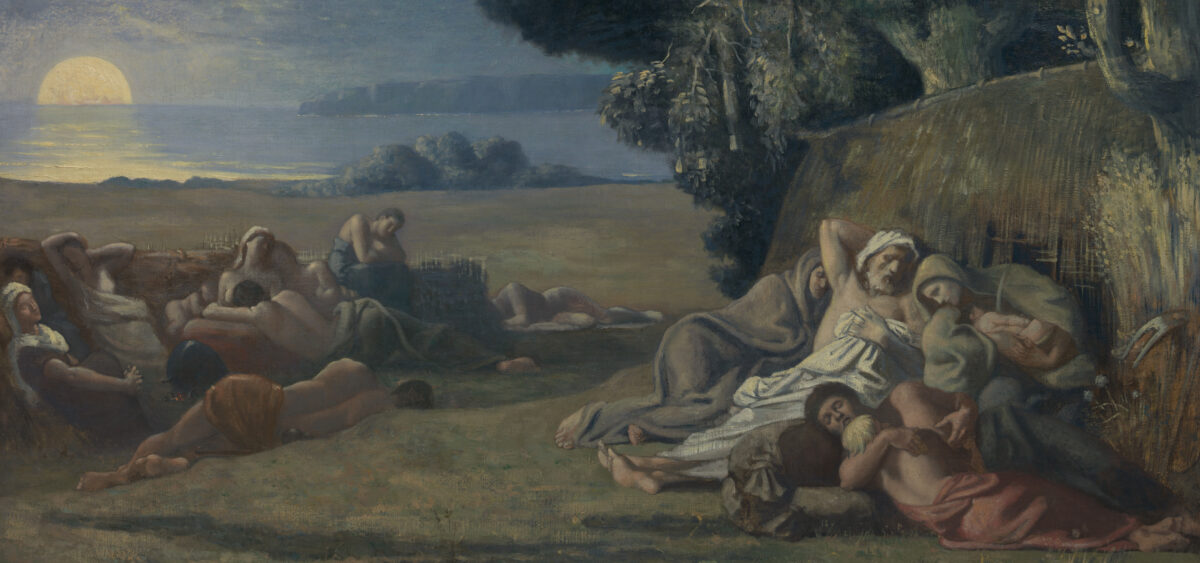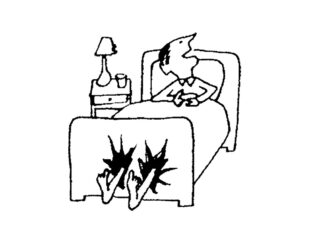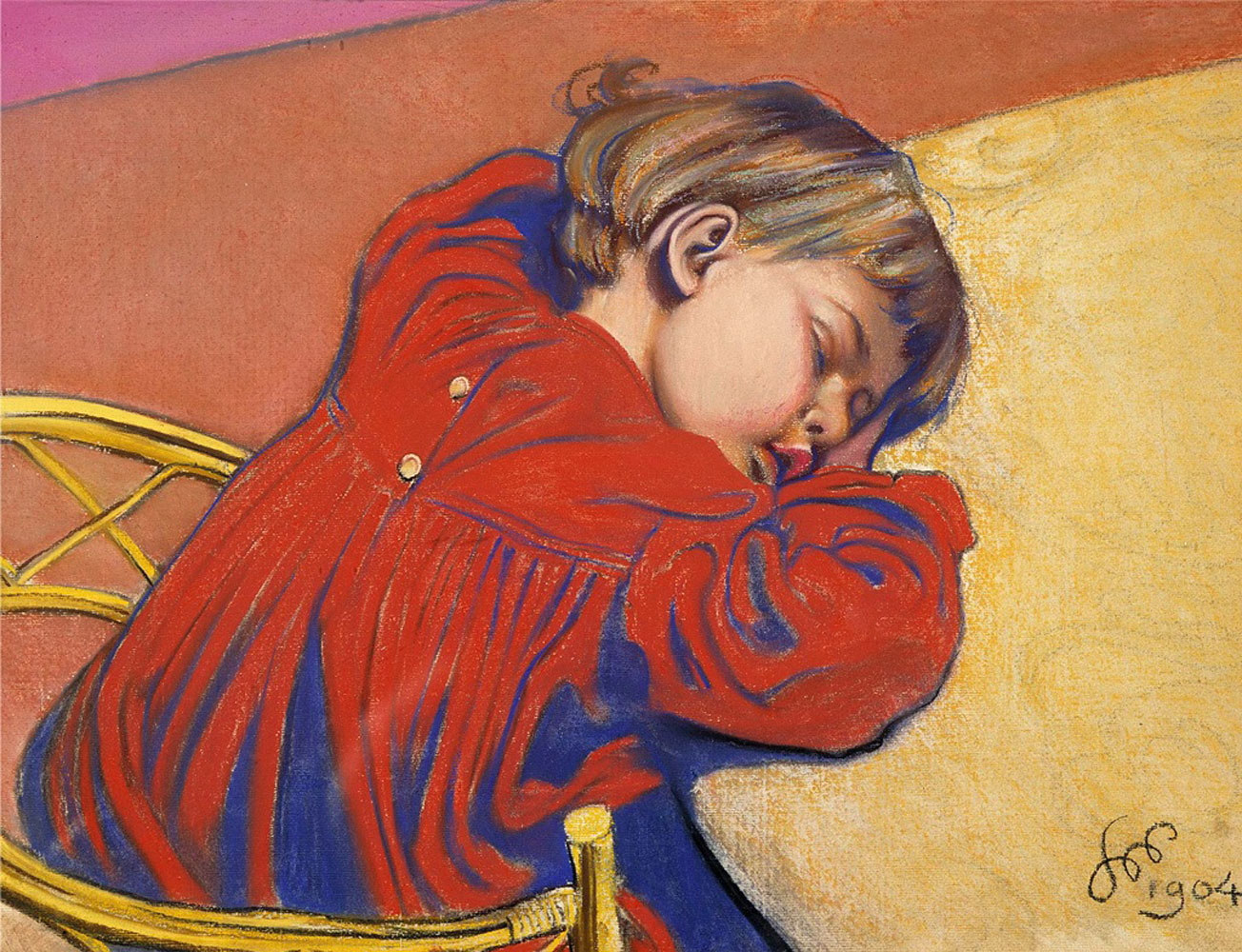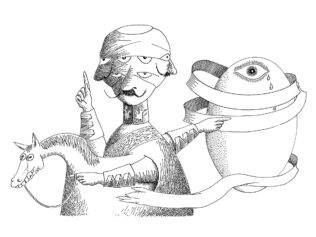
Eight hours of uninterrupted sleep in bed linen and on a comfortable mattress is a recent invention. Across different eras and cultures, night-time habits have considerable variety.
“Many Europeans don’t use a top sheet and instead sleep on a fitted sheet, underneath a comforter or duvet. (The duvet has its own cover, which can be taken off and washed just like sheets).” The mysterious bed habits of the continent of Europe were revealed to America by Time magazine only in 2017. To Europeans this all sounds as obvious as the fact that the human body is controlled by a biological clock. Yet if this was also so clear, three American scientists wouldn’t have won the Nobel Prize for its discovery in the not so distant past. Back in the 1980s, nothing was obvious. It is true that scientists have argued since the 18th century that mimosa leaves open in the morning and close at night (even when the plant is hidden from light), and in the mid-20th century a gene controlling the circadian rhythm in a fruit fly was identified. But only Jeffrey Hall, Michael Rosbash, and Michael Young examined this and two further genes (not only in fruit flies, but also in humans) more closely. They concluded that the proteins they produce connect with or block each other in a precise 24-hour rhythm—the same rhythm in which cortisol and melatonin dance in our bodies (controlled by the pineal gland regulated by the supply of light), managing the processes of waking up and falling asleep.
The Darkest Place Is Between the Street Lights
It seems that few things have changed society as much as mass access to light, also during the night. And this is not even about the invention of the light bulb, but above all about the street lighting system launched two centuries earlier. It first happened in Paris during the reign of Louis XIV in 1667—for the first time taxes were invested in hundreds and then thousands of oil lamps and candles hung on ropes. By the end of the 17th century, dozens of cities—including Amsterdam, Berlin, Vienna, and London—had begun to illuminate their streets, although even when the much brighter gas lighting appeared one hundred years later, the standards of street brightness had little to do with those of today. Suffice to say that, as the 18th-century memoirist James Boswell reported, it was still dark enough on London’s lantern-lined Westminster Bridge for him to do the deed with a sex worker without attracting any attention.
It wasn’t much brighter inside. “People came to terms with dark evenings because they didn’t know any others. A candle, a good candle, provides barely a hundredth of the illumination of a single 100-watt light bulb. Open your refrigerator door, and you summon forth more light than the total amount enjoyed by most households in the 18th century,” writes Bill Bryson in At Home: A Short History of Private Life. And yet this does not mean that people went to bed at sunset—on the contrary, especially in cities. Numerous diaries and memoirs show that social life in London flourished (a typical London theater, such as the Globe, could accommodate 2,000 people, one percent of the city’s population), and shops were open until 10:00 p.m.
The American historian Roger Ekirch, author of At Day’s Close: A History of Nighttime, discovered—using numerous sources, from diaries and chronicles to the Old Testament and Homer’s Odyssey—that for the majority of human history, not only did nobody repeat the wisdom of eight hours of sleep, but nobody had even heard of such an idea. Before the industrial era, with its artificial lighting systems and long, often eighteen-hour working day, people slept twice. The period between getting into bed and falling asleep lasted around two hours, during which people usually said a special prayer, or simply settled down. The “time of the first sleep” (in Latin: concubia nocte) lasted about four hours, depending on the season: from 8:00 p.m. to midnight, or from 10:00 p.m. to 2:00 a.m., followed by one to two hours of activity. During that time, people talked, visited neighbors, had sex, did laundry, prayed, or, as one of the chronicles reported, stole firewood from each other. It was then time for the second sleep, lasting until around sunrise (hence talk of “the morning sleep”). Some people recommended sleeping on the right side in the first sleep, and on the left in the second.
The first and second sleeping phases were typical until the spread of artificial light sources, i.e., until the end of the 19th century. Ekirch suspects that it is still imprinted on the brain so strongly that it may be one of the causes of insomnia in the middle of the night (every third adult American reportedly experiences sleep disorders). The fact that this is the most natural sleep rhythm is also evidenced by scientific research. In 1990, American psychiatrist Thomas Wehr checked how a group of volunteers would behave if given access to light for ten hours and plunged into darkness for the rest. It turned out that everyone quickly and in a similar way adapted to the new conditions—when darkness came, they fell asleep, after four hours they woke up for a period of two to three hours, before drifting off to sleep again. There are still people who function in such a rhythm, not only in laboratory conditions. Ekirch describes the Tiv people from Nigeria, who after a few hours of sleep wake up around midnight and talk to others. They also have separate terms for the first and second sleep.
Shakespeare and His Bed
Why did people wake up after four hours? The author of At Day’s Close suggests that one reason was a fear of ghosts and witches who were believed to prowl in the darkness of the night, casting charms. Above all, however, after a few hours of sleep people simply got cold, uncomfortable, and were bothered by insects. The bed was a luxurious piece of furniture, so much so that if someone had one, it was in good taste to display it in a central place in the living room. The most elaborate ones, with ornaments, a silk canopy, and several layers of mattresses and bedding, cost as much as a medium-sized farm. This puts in a completely different context a note from Shakespeare’s will, who gave his wife Anne Hathaway the “second best bed.” Here “second best” probably means that the spouses slept in it every day, so it seems that the bard, in fact, climbed the heights of romanticism and generosity.
Bedrooms were crowded (until the mid-19th century, the institution of “one’s own room” didn’t even exist; in poorer houses the tradition of sleeping as a whole family in one bed was popular even in the 20th century) and the dividing line was determined not by social class, but by gender. Boys slept alongside serving men, girls alongside serving women, servants shared sleeping space with their masters. The latter is said to have also been for security reasons—the diaries of Samuel Pepys show that a maid sleeping on the floor was supposed to be a kind of a burglar alarm, and the chroniclers of Henry V suggested that the butler and chamberlain did not leave their master’s bedroom even when he was having sex.
On a daily basis, however, wealthy spouses usually slept separately. In Victorian times, this was explained by hygiene. As the author of the 1883 guide Our Homes, and How to Make Them Healthy explained, at night “The water given out in respiration is loaded with animal impurities; it condenses on the inner walls of buildings, and trickles down in foetid streams, and evaporates or sinks into the walls.” Bryson also cites estimates by an American doctor who believed that about 40% of his countrymen die from exposing the body to unhealthy air during sleep. What this unhealthy air might have been was never explained, but sources suggest that this old intuition may not have been as ridiculous as it seems. It’s enough to read some historical reports about the cleanliness of floors. Although the top layer was cleaned regularly, all the dirt and everything that had spilled over the years (including vomit, dog urine, etc.) inevitably spoiled the air.
But if one were to travel back in time and spend the night as it used to be, it would probably not be the smell that would hinder sleep. British historian Ruth Goodman, who as part of the research for the book How to be a Tudor: A Dawn-to-Dusk Guide to Everyday Life personally tested all kinds of beds from the Tudor era (they ruled until the early 17th century, but sleeping conditions barely differed even three hundred years later), suggests that comfort was not a priority. Poorer people slept on the floor, and those who could boast about having a “bed” had in fact a wooden frame with stretched linen or hemp belts (their regular stretching was a separate duty of servants; metal nets and then spring mattresses appeared only in the mid-19th century), on which various types of prickly palliasses were laid. “Hay-filled beds are far more comfortable than straw beds, and there are even differences between types of straw. Barley straw is more comfortable than wheat straw, for example. […] Lady’s bedstraw, or Galium verum, was considered to be the finest,” writes Goodman.
Mattresses were also filled with feathers and down, which, if they were not subjected to regular airing and boiling, quickly began to stink, especially if the feathers were contaminated with bird feces right from the start. In addition, they attracted bed bugs and other vermin. A cheaper alternative to feathers was wool, to which moths were attracted. If they appeared, it was necessary to take out all the wool and boil it, although some deluded themselves that the insects would be repelled by bags of cow dung tied to the bed. Rats were also frequent visitors to the bedroom—an American woman wrote in 1867 that she and her sister took several pairs of shoes to bed to throw at uninvited rodent guests.
In the 1820s much more pleasant mattresses stuffed with horsehair became popular, but their use, as Bogusława Mańkowska of the Dąbrowski family wrote in her diaries, was long considered by supporters of tradition “a mortal sin and the Slavic tribe could not be forgiven for this softness.” They certainly would not say the same about other types of inserts popular in the 19th century: woodchips, seaweed, sawdust, or, as in the case of the bedding in Abraham Lincoln’s family home, corn husks.
Hay for the Guest
The modern American surprise at the fact that Europeans lie under a duvet in a duvet cover has roots dating back at least two centuries. In continental Europe, house chronicles often noted large amounts of bedding and covers. In her book W salonie i w kuchni [In the Living Room and Kitchen] Elżbieta Kowecka lists pillows, bristle headboards (throw pillows appeared only in the second half of the 19th century), quilts, eiderdowns, and satin throws, as well as a whole range of decorations of canvas, batiste, and muslin bedding covers, alongside crimson pillow cases, embroidery, hemstitches, and frills. Fastened with buttons or bone clips, the envelope duvet cover is an invention of the 1860s—previously the quilt was always covered and stitched into a kind of sheet with a wide hem.
Until the mid-19th century guest rooms were practically unknown. When a guest appeared in the house, they could not always count on a duvet, which is why cautious people took their own bundle containing feather beds, pillows, and a potty for their journey. In the best scenario, hosts gave guests the master bedroom, or ordered a simple wooden bed, previously washed outside with boiling water to get rid of bedbugs, to be put in one of the rooms. But often, even in wealthy mansions, a visitor could only count on fresh hay in the entrance hall or one of the larger halls, where they would be expected to unfold their own bedding. No one was outraged, except perhaps a French governess, who sighed: “You have to come to Poland to see the ambassador’s daughter, the general’s niece, and a future duchess lying on the ground and straw.” When there were more guests and there were not enough rooms, “male youth were accommodated in cottages, from which peasants were expelled” or even sent to a hay barn to sleep. Servants, except for the butler and governess, usually slept wherever they could.
Yet it is not certain whether such Europeans would have slept in two phases—and whether this is even the most beneficial form of sleep. When Ekirch’s book became famous, somnologists came forward and questioned the thesis about first and second sleeps. Two such experts from Los Angeles, Jerome Siegel and Gandhi Yetish, presented a theory according to which the most natural sleep for humans is one approximately six-hour-long phase of sleep. Siegel and Yetish carried out their research in three places around the world: Tanzania, Namibia, and Bolivia. In these countries, hunter-gatherer societies still live in accordance with nature because electricity and light pollution have not reached them yet—the night sky is only illuminated by the shine of the moon (such conditions are rare in the US, the EU, Japan, and South Korea, where light pollution is widespread). These hunter-gatherers, as it turns out, prefer six hours of sleep during the night and, especially in the summer months, about two hours of napping during the day, similar to a Spanish or Italian siesta.
Small Pleasures
It is often suggested that the greatest geniuses did not usually get enough sleep. Nikola Tesla made do with only two hours a day, at least until he had a nervous breakdown. Mozart, on the other hand, went to bed well after midnight, returning to the whirlpool of work after 6:00 a.m. Leonardo da Vinci was content with so-called polyphasic sleep—deep twenty-minute naps at four-hour intervals. Similarly, Thomas Edison struggled with sleep and would typically doze for around only three hours per day.
Nick Littlehales, author of Sleep: Change the Way You Sleep with this 90 Minute Read, is also a supporter of polyphasic sleep. He teaches outstanding athletes (soccer players from Chelsea and Real Madrid, the stars of the Tour de France) how to get enough rest. According to him, eight hours of sleep is a myth—ninety-minute cycles are much more effective. The sleep coach, however, enumerates a list of additional conditions. One cannot be too hot—the room temperature should be between 61 and 66 degrees Fahrenheit, and there is no question of wrapping oneself in a warm duvet (not to mention sleeping with a hot water bottle). Forget about scrolling Facebook or any other contact with your cell phone, tablet, or computer, and make sure to read any books outside the bedroom. One should also start turning off the lights long before going to bed; experts recommend lamps, candles, and replacing bright light bulbs in the bathroom with warm ones, so that they do not disrupt the body’s bedtime processes when brushing teeth in the evening.
If not even a sleep coach’s instructions prove successful, it’s worth considering whether the issue lies outside of night-time routines. In the meantime, try to enjoy small pleasures, such as the fact that the bed is not surrounded by rats.










